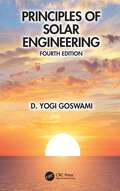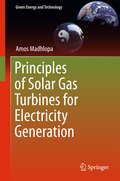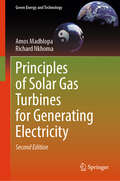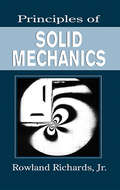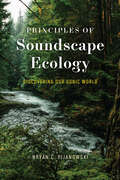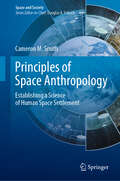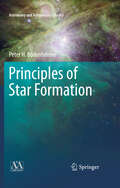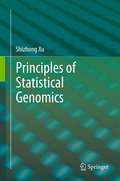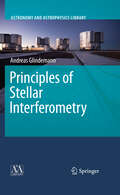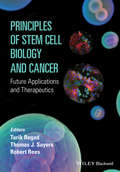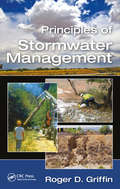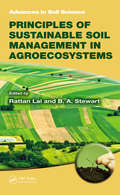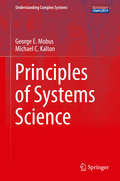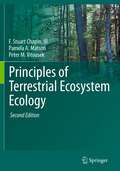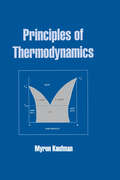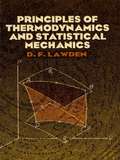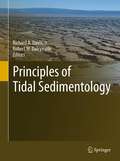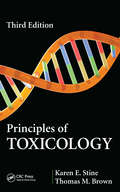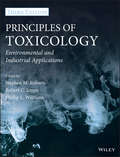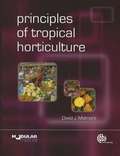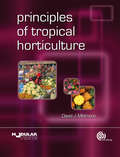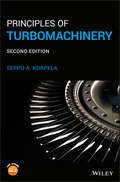- Table View
- List View
Principles of Solar Engineering
by D. Yogi GoswamiPrinciples of Solar Engineering, Fourth Edition addresses the need for solar resource assessment and highlights improvements and advancements involving photovoltaics and solar thermal technologies, grid power, and energy storage. With updates made to every chapter, this edition discusses new technologies in photovoltaics, such as organic, dye-sensitized, and perovskite solar cells, and the design of solar systems and power plants. It also features battery energy storage for distributed and bulk storage and electrical integration with the main solar systems. In addition, the book includes the latest advancements in concentrating solar power plants, such as supercritical CO2 cycle. Readers will benefit from discussions of the economics of the solar energy systems, which apply to all the systems covered in the subsequent chapters. Features: Discusses new forecasting models in solar radiation that are important to the economics and bankability of large solar energy systems, such as power plants. Includes expanded coverage of high temperature thermal storage for Concentrating Solar Thermal Power (CSP), including thermal energy transport using heat exchangers. Features a new chapter on solar seawater desalination. Includes new and additional end-of-chapter example problems and exercises. A Solutions Manual will be available for instructors. The book is intended for senior undergraduate and graduate engineering students taking Energy Engineering and Solar Energy courses.
Principles of Solar Gas Turbines for Electricity Generation (Green Energy and Technology)
by Amos MadhlopaThis is the first book dedicated to solar gas turbines, providing fundamental knowledge and state-of-the-art developments in the field. A gas turbine is a heat engine in which a mixture of fuel and air is burned in a chamber that is an integral part of the flow circuit of the working fluid. The burnt gas mixture expands and turns the turbine, which can be connected to a generator for electricity production. Solar gas turbines offer an important alternative to conventional gas turbines driven by non-renewable, polluting fossil fuels such as diesel or natural gas. The book provides a comprehensive overview of the topic as well as numerous illustrations.
Principles of Solar Gas Turbines for Generating Electricity (Green Energy and Technology)
by Amos Madhlopa Richard NkhomaThis book, now in its second expanded and updated edition, is dedicated to solar gas turbines, providing fundamental knowledge and state-of-the-art developments in the field. A gas turbine is a heat engine in which a mixture of fuel and air is burned in a chamber that is an integral part of the flow circuit of the working fluid. The burnt gas mixture expands and turns the turbine, which can be connected to a generator for electricity production. Solar gas turbines offer an important alternative to conventional gas turbines driven by non-renewable, polluting fossil fuels such as diesel or natural gas. The book provides a comprehensive overview of the topic as well as numerous illustrations. The second edition provides step-by-step linchpins from fundamentals to advanced concepts of solar gas turbines. The book features methods of designing and testing of this green technology. It includes economic and environmental considerations of solar gas turbines that are crucial for sustainable energy production. In addition, worldwide case studies on the development of solar gas turbines are presented in this book and each chapter contains worked examples.
Principles of Solid Mechanics (Mechanical and Aerospace Engineering Series)
by Jr., Rowland RichardsEvolving from more than 30 years of research and teaching experience, Principles of Solid Mechanics offers an in-depth treatment of the application of the full-range theory of deformable solids for analysis and design. Unlike other texts, it is not either a civil or mechanical engineering text, but both. It treats not only analysis but incorporates
Principles of Soundscape Ecology: Discovering Our Sonic World
by Bryan C. PijanowskiFrom a founding figure in the field, the definitive introduction to an exciting new science. What do the sounds of a chorus of tropical birds and frogs, a clap of thunder, and a cacophony of urban traffic have in common? They are all components of a soundscape, acoustic environments that have been identified by scientists as a combination of the biophony, geophony, and anthrophony, respectively, of all of Earth’s sound sources. As sound is a ubiquitous occurrence in nature, it is actively sensed by most animals and is an important way for them to understand how their environment is changing. For humans, environmental sound is a major factor in creating a psychological sense of place, and many forms of sonic expression by people embed knowledge and culture. In this book, soundscape ecology pioneer Bryan C. Pijanowski presents the definitive text for both students and practitioners who are seeking to engage with this thrilling new field. Principles of Soundscape Ecology clearly outlines soundscape ecology’s critical foundations, key concepts, methods, and applications. Fundamentals include concise and valuable descriptions of the physics of sound as well as a thorough elucidation of all sounds that occur on Earth. Pijanowski also presents a rich overview of the ecological, sociocultural, and technical theories that support this new science, illustrating the breadth of this amazingly transdisciplinary field. In methods, he describes the principles of data mining, signal processing, and mixed methods approaches used to study soundscapes in ecological, social, or socio-ecological contexts. The final section focuses on terrestrial, aquatic, urban, and music applications, demonstrating soundscape ecology’s utility in nearly all spaces.
Principles of Space Anthropology: Establishing a Science of Human Space Settlement (Space and Society)
by Cameron M. SmithThis book shows how anthropology can provide an innovative perspective on the human movement into space. It examines adaptation to space on timescales of generations, rather than merely months or years, and uses evolutionary adaptation as a guiding theme. Employing the lessons of evolutionary adaptation, Principles of Extraterrestrial Anthropology recommends evolutionarily-sound strategies of space settlement, covering genetics at the organismal and population levels. The author organizes the concept of cultural adaptation to environments beyond Earth according to observed patterns in human adaptation on Earth. He uses original artwork and tables to help convey complex information in a form accessible to undergraduate and graduate students. Though primarily written to engage students interested in space settlement and exploration, who will eventually build a full anthropology of space settlement, Principles of Extraterrestrial Anthropology is engaging to anthropologists across sub-disciplines, as well as scholars interested in the human dimensions of space exploration and settlement. Just as the term exobiology was invented only a few decades ago to shape the field of space life studies, exoanthropology is outlined to assist in the perpetuation of Earth life through human space settlement.
Principles of Star Formation
by Peter BodenheimerUnderstanding star formation is one of the key fields in present-day astrophysics. This book treats a wide variety of the physical processes involved, as well as the main observational discoveries, with key points being discussed in detail. The current star formation in our galaxy is emphasized, because the most detailed observations are available for this case. The book presents a comparison of the various scenarios for star formation, discusses the basic physics underlying each one, and follows in detail the history of a star from its initial state in the interstellar gas to its becoming a condensed object in equilibrium. Both theoretical and observational evidence to support the validity of the general evolutionary path are presented, and methods for comparing the two are emphasized. The author is a recognized expert in calculations of the evolution of protostars, the structure and evolution of disks, and stellar evolution in general. This book will be of value to graduate students in astronomy and astrophysics as well as to active researchers in the field.
Principles of Star Formation (Astronomy and Astrophysics Library)
by Peter BodenheimerUnderstanding star formation is one of the key fields in present-day astrophysics. This book treats a wide variety of the physical processes involved, as well as the main observational discoveries, with key points being discussed in detail. The current star formation in our galaxy is emphasized, because the most detailed observations are available for this case. The book presents a comparison of the various scenarios for star formation, discusses the basic physics underlying each one, and follows in detail the history of a star from its initial state in the interstellar gas to its becoming a condensed object in equilibrium. Both theoretical and observational evidence to support the validity of the general evolutionary path are presented, and methods for comparing the two are emphasized. The author is a recognized expert in calculations of the evolution of protostars, the structure and evolution of disks, and stellar evolution in general. This book will be of value to graduate students in astronomy and astrophysics as well as to active researchers in the field.
Principles of Statistical Genomics
by Shizhong XuStatistical genomics is a rapidly developing field, with more and more people involved in this area. However, a lack of synthetic reference books and textbooks in statistical genomics has become a major hurdle on the development of the field. Although many books have been published recently in bioinformatics, most of them emphasize DNA sequence analysis under a deterministic approach. Principles of Statistical Genomics synthesizes the state-of-the-art statistical methodologies (stochastic approaches) applied to genome study. It facilitates understanding of the statistical models and methods behind the major bioinformatics software packages, which will help researchers choose the optimal algorithm to analyze their data and better interpret the results of their analyses. Understanding existing statistical models and algorithms assists researchers to develop improved statistical methods to extract maximum information from their data. Resourceful and easy to use, Principles of Statistical Genomics is a comprehensive reference for researchers and graduate students studying statistical genomics.
Principles of Stellar Interferometry
by Andreas GlindemannThe imaging process in stellar interferometers is explained starting from first principles on wave propagation and diffraction. Wave propagation through turbulence is described in detail using Kolmogorov statistics. The impact of turbulence on the imaging process is discussed both for single telescopes and for interferometers. Correction methods (adaptive optics and fringe tracking) are presented including wavefront sensing/fringe sensing methods and closed loop operation. Instrumental techniques like beam combination and visibility measurements (modulus and phase) as well as Nulling and heterodyne interferometry are described. The book closes with examples of observing programmes linking the theory with individual astrophysical programmes.
Principles of Stem Cell Biology and Cancer
by Tarik Regad Robert Rees Thomas Sayersogress that has been made in their identification, as well as future therapeutic applications of stem cells. The second part focuses on cancer stem cells and their role in cancer development, progression and chemo-resistance. This section of the book includes an overview of recent progress concerning therapies targeting cancer stem cells. Features: An authoritative introduction to the link between stem cell biology and cancer. Includes contributions from leading international experts in the field. Well-illustrated with full colour figures throughout. This book will prove an invaluable resource for basic and applied researchers and clinicians working on the development of new cancer treatments and therapies, providing a timely publication of high quality reviews outlining the current progress and exciting future possibilities for stem cell research.
Principles of Stormwater Management
by Roger D. GriffinThis book presents of all aspects of storm water management: the hydrologic cycle, sources of contaminants, standards applicable to discharges, regulatory issues, atmospheric deposition, best management practices, and health/environmental impacts. It includes technical details of the modern treatment of stormwater, the emerging issues of atmospheric deposition, run-on, and snow melt, the Epidemiologic Model, and field data on discharge concentrations of a variety of contaminants. The principles explained in this book will enable students, contractors, developers, and engineers to grasp the most important field elements which must be included for construction projects impacting stormwater.
Principles of Sustainable Soil Management in Agroecosystems (ISSN)
by Rattan Lal B. A. StewartWith the use of high-level soil management technology, Africa could feed several billion people, yet food production has generally stagnated since the 1960s. No matter how powerful the seed technology, the seedling emerging from it can flourish only in a healthy soil. Accordingly, crop yields in Africa, South Asia, and the Caribbean could be double
Principles of Systems Science
by Michael C. Kalton George E. MobusThis pioneering text provides a comprehensive introduction to systems structure, function, and modeling as applied in all fields of science and engineering. Systems understanding is increasingly recognized as a key to a more holistic education and greater problem solving skills, and is also reflected in the trend toward interdisciplinary approaches to research on complex phenomena. While the concepts and components of systems science will continue to be distributed throughout the various disciplines, undergraduate degree programs in systems science are also being developed, including at the authors' own institutions. However, the subject is approached, systems science as a basis for understanding the components and drivers of phenomena at all scales should be viewed with the same importance as a traditional liberal arts education. Principles of Systems Science contains many graphs, illustrations, side bars, examples, and problems to enhance understanding. From basic principles of organization, complexity, abstract representations, and behavior (dynamics) to deeper aspects such as the relations between information, knowledge, computation, and system control, to higher order aspects such as auto-organization, emergence and evolution, the book provides an integrated perspective on the comprehensive nature of systems. It ends with practical aspects such as systems analysis, computer modeling, and systems engineering that demonstrate how the knowledge of systems can be used to solve problems in the real world. Each chapter is broken into parts beginning with qualitative descriptions that stand alone for students who have taken intermediate algebra. The second part presents quantitative descriptions that are based on pre-calculus and advanced algebra, providing a more formal treatment for students who have the necessary mathematical background. Numerous examples of systems from every realm of life, including the physical and biological sciences, humanities, social sciences, engineering, pre-med and pre-law, are based on the fundamental systems concepts of boundaries, components as subsystems, processes as flows of materials, energy, and messages, work accomplished, functions performed, hierarchical structures, and more. Understanding these basics enables further understanding both of how systems endure and how they may become increasingly complex and exhibit new properties or characteristics. Serves as a textbook for teaching systems fundamentals in any discipline or for use in an introductory course in systems science degree programs Addresses a wide range of audiences with different levels of mathematical sophistication Includes open-ended questions in special boxes intended to stimulate integrated thinking and class discussion Describes numerous examples of systems in science and society Captures the trend towards interdisciplinary research and problem solving
Principles of Terrestrial Ecosystem Ecology
by M. C. Chapin F. Stuart Chapin III Pamela A. Matson Peter M. VitousekFeatures review questions at the end of each chapter; Includes suggestions for recommended reading; Provides a glossary of ecological terms; Has a wide audience as a textbook for advanced undergraduate students, graduate students and as a reference for practicing scientists from a wide array of disciplines
Principles of Thermodynamics
by Jean-Philippe Ansermet Sylvain D. BrechetIn this introductory textbook, thermodynamics is presented as a natural extension of mechanics, so that the laws and concepts learned in mechanics serve to get acquainted with the theory. The foundations of thermodynamics are presented in the first part. The second part covers a wide range of applications, which are of central importance in the fields of physics, chemistry and engineering, including calorimetry, phase transitions, heat engines and chemical reactions. In the third part, devoted to continuous media, Fourier and Fick's laws, diffusion equations and many transport effects are derived using a unified approach. Each chapter concludes with a selection of worked examples and several exercises, to reinforce key concepts under discussion. A full solutions manual is available at the end of the book. It contains more than 150 problems based on contemporary issues faced by scientists and engineers that are solved in detail for undergraduate and graduate students.
Principles of Thermodynamics
by Myron KaufmanIdeal for one- or two-semester courses that assume elementary knowledge of calculus, This text presents the fundamental concepts of thermodynamics and applies these to problems dealing with properties of materials, phase transformations, chemical reactions, solutions and surfaces. The author utilizes principles of statistical mechanics to illustrat
Principles of Thermodynamics and Statistical Mechanics
by D. F. LawdenA thorough exploration of the universal principles of thermodynamics and statistical mechanics, this volume explains the applications of these essential rules to a multitude of situations arising in physics and engineering. It develops their use in a variety of circumstances--including those involving gases, crystals, and magnets--in order to illustrate general methods of analysis and to provide readers with all the necessary background to continue in greater depth with specific topics.Author D. F. Lawden has considerable experience in teaching this subject to university students of varied abilities and backgrounds. Well acquainted with which concepts and arguments sometimes prove problematic, he presents the potentially difficult sections with particular care. Students can supplement their understanding by working through the numerous exercises which appear throughout the text. Mathematical physicists will find this volume of particular value, as will engineers requiring a basic but comprehensive introduction to the principles of thermodynamics and statistical mechanics.
Principles of Tidal Sedimentology
by Richard A. Davis Jr. Robert W. DalrympleThis book presents a comprehensive, contemporary review of tidal environments and deposits. Individual chapters, each written by world-class experts, cover the full spectrum of coastal, shallow-marine and even deep-marine settings where tidal action influences or controls sediment movement and deposition. Both siliciclastic and carbonate deposits are covered. Various chapters examine the dynamics of sediment transport by tides, and the morphodynamics of tidal systems. Several chapters explore the occurrence of tidal deposits in the stratigraphic context of entire sedimentary basins. This book is essential reading for both coastal geologists and managers, and geologists interested in extracting hydrocarbons from complex tidal successions.
Principles of Toxicology
by Thomas M. Brown Karen E. StineReflecting the broad and interdisciplinary nature of toxicology, this third edition of Principles of Toxicology explores the biochemical, physiological, and environmental aspects of the subject.This new edition is updated and revised to include reference to several major new directions in the science of toxicology, including significant changes in
Principles of Toxicology: Environmental and Industrial Applications
by Stephen M. Roberts Robert C. James Phillip L. WilliamsA fully updated and expanded edition of the bestselling guide on toxicology and its practical application • Covers the diverse chemical hazards encountered in the modern work and natural environment, and provides a practical understanding of these hazards • New chapters cover the emerging areas of toxicology such as omics, computational toxicology, and nanotoxicology • Provides clear explanations and practical understanding of the fundamentals necessary for an understanding of the effects of chemical hazards on human health and ecosystems • Includes case histories and examples from industry demonstrate the application of toxicological principles • Supplemented with numerous illustrations to clarify and summarize key points, annotated bibliographies, and a comprehensive glossary of toxicological terms
Principles of Toxicology: Environmental and Industrial Applications
by Stephen M. RobertsPrinciples of Toxicology concisely and efficiently presents the scientific basis for toxicology as it applies to the workplace and the environment, covering diverse chemical hazards encountered in modern workplaces and natural environments and providing a practical understanding of these hazards for those concerned with protecting the health of humans and ecosystems. The work presents not only theory, but also practical information regarding chemical hazards to give the student and new professional a working knowledge of the practice of toxicology and the ability to solve problems in environmental and industrial settings. Case histories and examples from industrial and environmental exposures to chemicals are included to demonstrate the application of toxicological principles. To allow for seamless reader comprehension and further exploration of covered topics, the work is supplemented with numerous illustrations to clarify and summarize key points, as well as annotated bibliographies. In the 4th edition, all chapters and references have been updated to account for the latest scientific thinking, and new color figures have been added. New topics covered in 4th Edition of Principles of Toxicology include: Regulatory toxicology, including the key regulatory framework in which much of the field of toxicology operates Alternative methods in toxicology, including cutting-edge approaches to developing new information on the toxicity of drugs and chemicals The dilemma of selecting safe exposure limits, guiding readers through practical considerations and pitfalls in developing and using safe exposure limits Ecological risk assessment, with detailed discussion of methods and considerations when evaluating the effects of contaminants on plants and animals.Providing information on the principles of toxicology and the application of those principles to solve problems in environmental and industrial settings, Principles of Toxicology serves as an excellent textbook resource for advanced undergraduate, graduate, and professional students in a range of environmental and health fields. It is also valuable to health professionals who need toxicological information and assistance beyond what is found in an introductory text to general toxicology.
Principles of Tropical Horticulture
by David MidmorePrinciples of Tropical Horticulture leads the reader through a background of environmental influences and plant physiology to an understanding of production and post-harvest systems, environmental adaptation techniques and marketing strategies. Focusing on the principles behind production practices and their scientific basis, rather than detailed biological traits of each crop, this text outlines successes and failures in practices to date and sets out how the quantity and quality of horticultural produce can improve in the future. Case studies are frequently used and chapters cover the production of vegetables, fruit and ornamental crops, including temperate zone crops adapted to grow in the tropics. Read a chapter for free.
Principles of Tropical Horticulture (Animal And Veterinary Science Ser.)
by David MidmorePrinciples of Tropical Horticulture leads the reader through a background of environmental influences and plant physiology to an understanding of production and post-harvest systems, environmental adaptation techniques and marketing strategies. Focusing on the principles behind production practices and their scientific basis, rather than detailed biological traits of each crop, this text outlines successes and failures in practices to date and sets out how the quantity and quality of horticultural produce can improve in the future. Case studies are frequently used and chapters cover the production of vegetables, fruit and ornamental crops, including temperate zone crops adapted to grow in the tropics.
Principles of Turbomachinery
by Seppo A. KorpelaA newly updated and expanded edition that combines theory and applications of turbomachinery while covering several different types of turbomachinery In mechanical engineering, turbomachinery describes machines that transfer energy between a rotor and a fluid, including turbines, compressors, and pumps. Aiming for a unified treatment of the subject matter, with consistent notation and concepts, this new edition of a highly popular book provides all new information on turbomachinery, and includes 50% more exercises than the previous edition. It allows readers to easily move from a study of the most successful textbooks on thermodynamics and fluid dynamics to the subject of turbomachinery. The book also builds concepts systematically as progress is made through each chapter so that the user can progress at their own pace. Principles of Turbomachinery, 2nd Edition provides comprehensive coverage of everything readers need to know, including chapters on: thermodynamics, compressible flow, and principles of turbomachinery analysis. The book also looks at steam turbines, axial turbines, axial compressors, centrifugal compressors and pumps, radial inflow turbines, hydraulic turbines, hydraulic transmission of power, and wind turbines. New chapters on droplet laden flows of steam and oblique shocks help make this an incredibly current and well-rounded resource for students and practicing engineers. Includes 50% more exercises than the previous edition Uses MATLAB or GNU/OCTAVE for all the examples and exercises for which computer calculations are needed, including those for steam Allows for a smooth transition from the study of thermodynamics, fluid dynamics, and heat transfer to the subject of turbomachinery for students and professionals Organizes content so that more difficult material is left to the later sections of each chapter, allowing instructors to customize and tailor their courses for their students Principles of Turbomachinery is an excellent book for students and professionals in mechanical, chemical, and aeronautical engineering.
